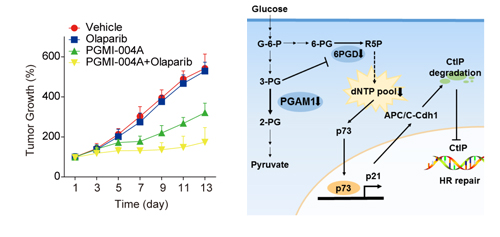
Deregulated metabolism is a hallmark of cancer. Different from most normal differentiated cells, tumor cells tend to metabolize glucose via aerobic glycolysis. This rewired metabolism ensures the elevated requirements of cancer cells for the production of biomass, including fatty acids, amino acids, and nucleotides, to support unrestricted cell growth.
PGAM1 is a glycolytic enzyme that catalyzes the conversion of 3-phosphoglycerate (3-PG) into 2-phosphoglycerate (2-PG) in glycolysis. By converting 3-PG into 2-PG, PGAM1 also functions to stimulate pentose phosphate pathway (PPP) and serine generation. This unique position in metabolic network makes PGAM1 an attractive target for anticancer therapy. However, the therapeutic promise of PGAM1 in cancer remains to be better defined.
Scientists from Shanghai Institute of Materia Medica (SIMM) of Chinese Academy of Sciences made progress in discovering the role of the metabolic enzyme phosphoglycerate mutase 1 (PGAM1) in maintaining genomic stability, and found that PGAM1 inhibitors have the potential to expand the therapeutic benefits of FDA-approved ovarian cancer Olaparib (Lynparza) to a wider range of cancer types than currently indicated, such as triple-negative breast cancer. This study was published in The Journal of Cell Biology.
Researchers discovered that PGAM1 inhibition resulted in a defect in the synthesis of deoxynucleotide triphosphates (dNTPs) – the building blocks of DNA. This, in turn, activated a cellular stress that degraded CtIP, a protein required for homologous recombination repair, an essential repair pathway specifically repairing double-stranded lesions of genomic DNA. In this way, PGAM1 inhibition shuts down the power supply for DNA repair in cancer cells and cells gain a phenotypic change called “BRCAness”, which mimics mutation of tumor suppressor genes BRAC1/2 in sporadic cancer.
These findings revealed a therapeutic indication for PGAM1 inhibitors, as cancers carrying BRCA1 and BRCA2 mutations are known to exhibit susceptibility to poly ADP ribose polymerase (PARP) inhibitor Olaparib, which was approved by the FDA in 2014 to treat ovarian cancers with BRCA mutations.
In this study, researchers showed that combination with a PGAM1 inhibitor (PGAMI-004A) to impair homologous recombination repair sensitizes triple-negative breast cancers containing functional BRCA1 and BRCA2 genes to Olaparib. This study may provide a therapeutic solution for triple-negative cancers that currently lack effective therapies and reveal a potential therapeutic opportunity for PGAM1 inhibitors.
This work was supported by the China International Science and Technology Cooperation Program, the National Science and Technology Major Project, the Strategic Priority Research Program of the Chinese Academy of Sciences, the Natural Science Foundation of China for Innovation Research Group, etc.

Figure: PGAM1 inhibition sensitizes triple-negative breast cancer xenograft models to Olaparib (Left); A schematic model shows the role of PGAM1 in promoting homologous recombination repair in responding to genomic stress (Right). (Image by SIMM)

86-10-68597521 (day)
86-10-68597289 (night)

86-10-68511095 (day)
86-10-68512458 (night)

cas_en@cas.cn

52 Sanlihe Rd., Xicheng District,
Beijing, China (100864)

